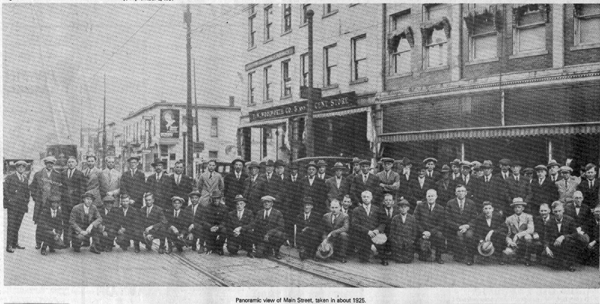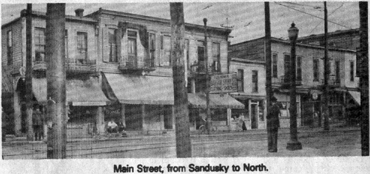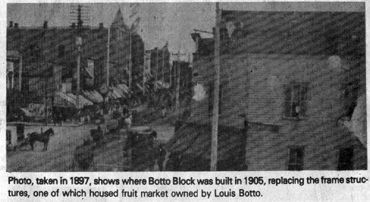September 3, 1981



AUTHOR’S NOTE: Today’s story is the first of three about the east side of Main Street, from Sandusky to Center. It is a story I have anticipated doing, but delayed, waiting to find the photos to illustrate it. Like many other occasions, eventually my needs have been supplied. For today’s article instead of many photos, there became available one which tells pictorially most of the story. That one photo covers that two-block area of Main Street. However, because of the size of the photo, it is necessary to divide in into three parts to suit printing limitations.
By saving today’s story and the next two, they can be pasted together and readers will then have a copy of the original photo, which was taken by W.H. Weaver more than 50 years ago. Weaver specialized in group and outdoor photos, not portrait. When he died, all of his negative files, including glass plates were destroyed, thus losing forever many historical photos of Fostoria. Even his son Paul, still residing in Fostoria, did not have a photo of his father to use with this article, to remind readers of him and his chosen profession.
The photo is from Ray Dell’s collection.
MEN’S BIBLE CLASS
The photo used with today’s article and the next two, was not originally intended to preserve Fostoria’s Main Street history when it was taken by Weaver back in about 1925.
It’s primary purpose was to provide memory of the achievement of Rev. E.L. Miley, pastor of the church of Christ, in establishing the Every Man’s Bible Class.
The class, held every Sunday morning in the Colonial Theatre, drew large crowds, including many who had no church affiliation. Rev. Miley was the teacher; A.R. Keiser, president; Clark Richard, chorister; Juanita Sprague, pianist…she being the only woman in the picture at the top of the page. Rev. Miley is immediately left of the sign in front, Keiser to his left, and Richards on the right of Sprague.
No attempt was made to identify all of the faces in the photo, but in one segment of the story, depending on that day’s available space, will be a list of those identifiable, without relation to where in the photo. Many readers will recognize faces of friends and relatives.
The photo at the top of the page starts at Sandusky Street, however, the other photo at the right, on top, tells part of today’s story better, pictorially, to match the descriptive data for that area.
In the photo at the top can be seen an electric interurban being delayed for the picture taking.
IMPORTANT AREA
From Sandusky to North was an active business area 50 to 75 years ago. The stores in that area were housed in frame buildings owned by two families. The Cadwallader family owned the property at the corner of North and Main Streets, where there has been a gasoline station for many years, operated by a group of investors since 1935, with C.J. Stahl, the initial overseer, and since his death by Glenn Stahl, his son.
The N.E. George family owned the remaining buildings to Sandusky Street. They continued ownership until a few years ago, even though they no longer lived here, but eventually sold the land to Glenn Stahl and he in turn sold it to George Pappas who has converted it into a parking lot for the Candyland Restaurant.
The Cadwallader Company still own the one plot, where the present Marathon filling station is now. Ira “Ike” Cadwallader recalls the demolition of the building on their plot. He says he was just in grade school then, and his father Lester, hired him as a water boy for the crew of men who did the demolition.
As mentioned in other Potluck articles, city directories only started to list residences and businesses in 1915, and that is the case in the following list, which starts at the corner of North and Main streets and moved north, including the Sandusky Street area.
REMEMBER THESE 150?
200 – E.C. Wilcox, saloon; Brunswick Pool Room, proprietors Fakalos and Lianos; Peter Tsantles Grocery; Charles Rossie Grocery; Sunoco Service Station.
202 – C.M. Seigchrist, jewelry shop; C.B. Howell, wallpaper, paints, varnishes, sewing machines, picture frames; Globe Grocery Store, C.H. Fenton manager, then Glenn Stout, manager; Fostoria Lunchroom, proprietor Peter Mandel.
204 – Penny Arcade – Billard Parlor, proprietor G.W. Keller; Johnson – Roberts billiard parlor; Bee Hive Store, Pete Tsantles, proprietor.
206 – Albert R. Smith, cigar, tobacco and confections; Mike Brown Shoe Repair; Nick Brown, shoemaker.
208 – H.E. Kimball, shoes; John Ballas, bootblack; J.C. Mundorff and F.W. Gregory, barbers; Charles Allison Barber Shop, William F. Clary, billiard parlor.
212 – John L. Droll, saloon; Charles Allison, barbershop; Lewis & Snouffer Grocery; Peoples Cash Meat Market, H.A. Moberly and J.W. Steiff, proprietors; The City Market George Bros., Bob and Joe, proprietors; Lavery’s Delicatessen; “Tug” Elmer Rogers, delicatessen.
214 – Ralph “Skip” Emison restaurant.
SANDUSKY STREET
103 – R.W. Emison, milk depot; Ben Lewis Lunchroom.
105 – Ira Johnson Lunchroom; Tillie’s Lunchroom, Tillie Bishop and Robert Barton; John Geiger, barber; Lavery’s Delicatessen; Oliver J. Leech, barber.
103-105 – Ira Johnson, confectionery; F.T. Ort, grocery and confectionery.
109 – J.J. Ghaster, foreman, Ghaster Poster Advertising Co.; Michael Spires, saloon
113 – O.K. Jewelers, S.W. Grromes, proprietor; Park Stouffer, barber; Ira Johnson, barber; Miller’s Lunchroom, H.L. Miller, proprietor.
Some of the people who resided in the upstairs of the buidling on Main Street were: Frank Homan, Jesse Brown, Mrs. Mary Clary, Mrs. Hazel M. Harr, Mary Carman, Mr. and Mrs. G.C. Munro, Mr. and Mrs. Lee Clark, Mr. and Mrs. James L. Smith, John J. Ghaster, Mrs. E.W. Bodkins and Mr. and Mrs. Dean Claypool.
In the small photo of the business area from North to Sandusky, can be seen some identifying features, relating to the various businesses. In the right can be seen an outdoor clock…that is where C.M. Siechrist Jewelry Shop was located, also Globe Grocery location at another time.
SEE SMALL PHOTO
The low, two-story building is where the Brown brothers had their shoe repair shop at one time. With a magnifying glass, there can be seen in the original photo a sign showing shoes of that era.
Emison’s Restaurant was in the building in extreme left of photo. A sign on the awning reads “Ice cold lemonade”.
At the corner of Sandusky and Potter streets was the large frame house which still is there. Back then it was occupied by the C.W. Stockwell family and later the Fakalos family, with several others up to now.
Another large frame house that stood in that block has been gone for many years. The only one still standing is the cement block, two-story building, used as a place for many businesses and residences.
I am sure that there were other businesses that could be added to the above list, but directories back then were not published every year, and in between editions there were others that were born and died. Readers may know some of them, and perhaps will tell me.
PERSONAL THOUGHTS
Your author was well acquainted with that area for the years from about 1912 until the old buildings were demolished, and I have some good memories of the people and businesses that were there.
I remember going into Charles Allison’s Barbershop to collect for The Review. He usually gave me a tip. He and my father were barbers in the Hays House Barbershop earlier.
I remember the Brown brothers, Frank, Joe, Nick and Mike. I took many pairs of shoes to them for repair. Back then shoes were repaired more than today. Of all the boys, Nick was my favorite.
The one item I especially remember buying from Globe Grocery was the coconut bars. They are still available in supermarkets, but now they are prepackaged. Back then they were sold in bulk and were inexpensive. I still enjoy them, dipped in milk or coffee. Oh my! Glenn Stout was manager at Globe then and Albert Clary, a school boy friends of mine, worked there. Stout is gone, but Clary lives in Columbus,
I remember the candy stores on Sandusky Street were favorites of kids. All kinds of penny candy…all-day suckers, licorice, hears, jelly beans, etc.
I remember about Emison’s Restaurant and “Skip”. I recall the rhymes he made up on the spur of the moment; sometimes about the customers. They enjoyed it. Often he had rhymes painted on the front windows to attract customers. Quite a guy. Good food and low prices. Some readers will recall that his wife, Mollie, son Dewey and daughter Calra, all assisted in making the restaurant a good place to eat.
“Ike” Cadwallader reports that Dewey’s daughter still resides in Columbus, where the family moved after leaving Fostoria.
George Pappas, of Candyland, believes that Bert Azzar was the cook at Emison’s place when he first came to town. Later Azzar had his own restaurant in town.
This closes a page of history about another Main Street area.
BOTTO BLOCK
The large photo with today’s story shows the Botto Block, the southeast corner of Main and North streets. The Botto Block was built in 1905 by Louis Botto, Fostoria, and Mr. Lavagi, Tiffin. Botto had operated a fruit market in a frame building at that location earlier.
The F.W. Woolworth store came to Fostoria in 1916 and took a 99-year lease on the first floor of the Botto Block, but only occupied half of it initially. The local Woolworth store quit business in 1956. Later Lanes took over that space in the Botto Block.
When Woolworth occupied only part of the first floor in the Botto Block the Zemer and Orwig Drug Store used the remainder of the space.